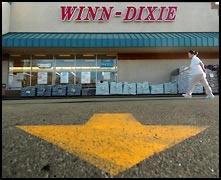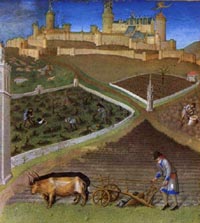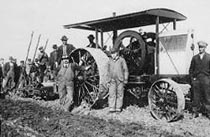| (insert your NIE or newspaper logo here) | Weekly Online LessonOnline Lesson ArchiveGrade Level: 5-8
|
Farming Food
 One of the nation's oldest supermarket chains, Winn-Dixie, announced
on Tuesday, February 22, 2005, that it had filed for bankruptcy.
One of the nation's oldest supermarket chains, Winn-Dixie, announced
on Tuesday, February 22, 2005, that it had filed for bankruptcy.
The company cited the overwhelming competition in the food retail business that it has faced in recent years as the major reason for their losses.
Changes in how food gets to the consumer has been strongly influenced by shifts in consumer habits as well as improvements in food production, packaging, and delivery.
Basically, Winn-Dixie hasn't done well in adapting to change. Meanwhile, other retailers, like Wal-Mart, which offers one-stop shopping, and other supermarket chains and corner convenience stores, which often provide a growing diversity of choices, are doing well.
Just as food retailers have had to adapt to a changing environment, so has food production.
Humans began cultivating crops thousands of years ago, changing the human way of life forever. By creating relatively predictable and high-yield food sources, families could live permanently in one area, instead of needing to migrate with the seasons.
Today, many farmers are hi-tech - using satellites, chemicals, and genetics to boost crop yields and produce vegetables that stay fresh longer.
Consumers have benefited by the ease of finding what they want at an affordable price.
For this week's lesson, you'll discover what's in your pizza and how it got there, then you'll take a tour of the evolution of farming - in the United States and in other parts of the world
From Field to Pizzeria
 Let's start with an introduction into agriculture at the USDA site,
Agriculture in the Classroom.
Let's start with an introduction into agriculture at the USDA site,
Agriculture in the Classroom.
Jump to the Teen Scene, enter, then select the section, AgroWorld.
Click on the TV set on the right to watch the movie. Can you list 10 or more products you own or use that are directly linked to agriculture?
As you may guess, agriculture is about more than just the farmer. Many different types of professionals are involved in the production, packaging, and delivery of food. To learn more about some of these professionals, click the tab titled Career Opportunities, then browse some of the Career Choices & Salaries.
What kinds of specialty fields are involved in agriculture? Do you ever see different types of professionals who are involved in agriculture in some way (for example, people who deliver produce or fertilizer, restaurant workers, vendors at a local farmers market, etc.)? If so, where have you seen them and what exactly do they do? Can you link any of them, directly or indirectly, to your personal food sources?
Now check out the Edutainment & Games section, and launch The Pizza Explorer.
Click Start, then Start The Pizza Explorer. Choose the Left Brain Interface, the Right Brain Interface, or visit The Configurator to help you decide on which direction to take.
Begin by reading The Evolution of the Pizza. How did the tomato become the fundamental ingredient of the pizza? In what ways did the varieties of pizza evolve with the local farming products and social cultures?
Also, click on any of the ingredients to learn about the related Nutritional Composition, Food Processing, Food Chemistry, and Hot Topics for each of them. Then, test your knowledge of each ingredient with a Quiz.
Can you name some other products that use one or more of the pizza ingredients? How does each ingredient compare in its nutritional composition and chemistry? How exactly did the processing of each food item evolve?
Cultivating A Lifestyle
 Now it's time to explore the evolution of farming. To do that, let's
head over to the Agropolis Museum in France.
Now it's time to explore the evolution of farming. To do that, let's
head over to the Agropolis Museum in France.
Here, let's begin with the History of food and agriculture, reviewing Pre-agricultural times, Agricultural times, and Agro-Industrial times.
What significant inventions helped to improve the farming process? In what ways did social groups change as a result of improved farming and the domestication of animals? In what ways did the transfer of plant species from their native areas to non-native areas improve agriculture? How did the transfer shape the food culture in different regions?
Next, let's take a look at Farmers and farming all over the world.
Compare the farmers and their farming conditions by clicking on the countries featured on the map:
 In what ways do the geological and ecological
conditions influence what the farmers can produce? What are the economic
challenges that each farmer must manage? How does the federal government
affect each farmer and his farming operation? In what way does their
occupation fit into their local social structure? Have the farmers been
affected by any global conditions or trends?
In what ways do the geological and ecological
conditions influence what the farmers can produce? What are the economic
challenges that each farmer must manage? How does the federal government
affect each farmer and his farming operation? In what way does their
occupation fit into their local social structure? Have the farmers been
affected by any global conditions or trends?
Lastly at this site, browse the Banquet of Humanity to compare the diets of different regions. How do the major foods consumed by residents relate to the geography of where they live?
Let's return to the United States for more Agriculture in the Classroom, and zoom in on A History of American Agriculture.
Review the timeline by decade, starting with the 17th-18th Centuries, then moving through the 1800s and 20th Century.
Afterward, you can also compare agricultural developments by category.
 In what specific ways were farmers and farming methods affected
by changes in:
In what specific ways were farmers and farming methods affected
by changes in:
-
Science?
-
Technology?
-
Economics?
-
Politics?
-
Society
-
Consumer Habits?
Which top 10 events, since the 17th Century, would you list as having the strongest influence on agriculture in the United States? How would you compare or contrast these influences with those in other countries?
If you have time, check out the State Agricultural Profiles (Acrobat Reader required).
Compare two or more states either in the same region or in different regions. What's the climate like? How much cropland and pasture land exists in the state? How many farms are there and what's the average farm size? What are the primary crops grown? What types of animals are raised there?
Newspaper Activities
Look through issues of The Salt Lake Tribune to find photos or stories about food, farmers, or any topic related to agriculture. If you find one about food, where did the food sources originate? If you locate a recipe, try tracking down the nutritional composition of the product. If the story is about farmers, do the farmers live locally or in your general region? If so, how far away do they live from your home or school? What social, political, or economic forces are affecting them the right now? What scientific or technological advances are helping them be more productive?
© Copyright 2005
Learners
Online, Inc.
